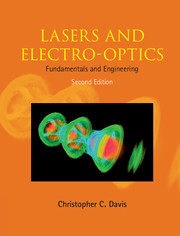Book contents
- Frontmatter
- Contents
- Preface to the Second Edition
- 1 Electromagnetic waves, light, and lasers
- 2 Optical frequency amplifiers
- 3 An introduction to two practical laser systems
- 4 Optical resonators containing amplifying media
- 5 Laser radiation
- 6 Control of laser oscillators
- 7 Optically pumped solid-state lasers
- 8 Gas lasers
- 9 Molecular gas lasers I
- 10 Molecular gas lasers II
- 11 Tunable lasers
- 12 Semiconductor lasers
- 13 Passive optical systems
- 14 Periodic optical systems, resonators, and inhomogeneous media
- 15 The optics of Gaussian beams
- 16 Optical fibers and waveguides
- 17 The optics of anisotropic media
- 18 The electro-optic and acousto-optic effects and modulation of light beams
- 19 Introduction to nonlinear processes
- 20 Wave propagation in nonlinear media
- 21 Detection of optical radiation
- 22 Coherence theory
- 23 Laser applications
- Appendix 1 Optical terminology
- Appendix 2 The ´-function
- Appendix 3 Black-body radiation formulas
- Appendix 4 RLC circuits
- Appendix 5 Storage and transport of energy by electromagnetic fields
- Appendix 6 The reflection and refraction of a plane electromagnetic wave at a boundary between two isotropicmedia of different refractive indices
- Appendix 7 The vector differential equation for light rays
- Appendix 8 Symmetry properties of crystals and the 32 crystal classes
- Appendix 9 Tensors
- Appendix 10 Bessel-function relations
- Appendix 11 Green's functions
- Appendix 12 Recommended values of some physical constants
- Index
- References
13 - Passive optical systems
Published online by Cambridge University Press: 05 June 2014
- Frontmatter
- Contents
- Preface to the Second Edition
- 1 Electromagnetic waves, light, and lasers
- 2 Optical frequency amplifiers
- 3 An introduction to two practical laser systems
- 4 Optical resonators containing amplifying media
- 5 Laser radiation
- 6 Control of laser oscillators
- 7 Optically pumped solid-state lasers
- 8 Gas lasers
- 9 Molecular gas lasers I
- 10 Molecular gas lasers II
- 11 Tunable lasers
- 12 Semiconductor lasers
- 13 Passive optical systems
- 14 Periodic optical systems, resonators, and inhomogeneous media
- 15 The optics of Gaussian beams
- 16 Optical fibers and waveguides
- 17 The optics of anisotropic media
- 18 The electro-optic and acousto-optic effects and modulation of light beams
- 19 Introduction to nonlinear processes
- 20 Wave propagation in nonlinear media
- 21 Detection of optical radiation
- 22 Coherence theory
- 23 Laser applications
- Appendix 1 Optical terminology
- Appendix 2 The ´-function
- Appendix 3 Black-body radiation formulas
- Appendix 4 RLC circuits
- Appendix 5 Storage and transport of energy by electromagnetic fields
- Appendix 6 The reflection and refraction of a plane electromagnetic wave at a boundary between two isotropicmedia of different refractive indices
- Appendix 7 The vector differential equation for light rays
- Appendix 8 Symmetry properties of crystals and the 32 crystal classes
- Appendix 9 Tensors
- Appendix 10 Bessel-function relations
- Appendix 11 Green's functions
- Appendix 12 Recommended values of some physical constants
- Index
- References
Summary
Introduction
Practical photonic systems can conveniently be divided into four distinct parts: (a) the optical source (or sources), (b) a passive optical structure, (c) an active optical structure, and (d) a detection system. A good example of such a system is the human eye, which is shown schematically in Fig. 13.1. In this system the source of light is the Sun, or artificial lighting that renders objects visible to the eye. The passive optical structure includes the cornea, the intraocular fluid, and other fixed structures in the eye. The active optical structure includes the deformable eye lens, whose shape is controlled by the ciliary muscles, and the iris, whose diameter is adjusted to control the amount of light entering the eye. The detector in this system is the retina, where photons are absorbed by special molecules, leading to chemical reactions that produce charges and subsequent electrical signals to the brain along the optic nerve.
We have already explored in some detail the fundamental physics, constructional details, and properties of lasers.We have also seen the connection between the amplifying medium and the optical structures that turn the laser amplifier into an oscillator. In this and the following chapters we will further examine the characteristics of various passive and active optical structures that are important in photonic systems. Initially we will discuss the characteristics of important passive optical components and systems. These will include optical materials, lenses, mirrors, prisms, diffraction gratings, interferometers, crystals, polarizers, and optical fibers.
- Type
- Chapter
- Information
- Lasers and Electro-opticsFundamentals and Engineering, pp. 361 - 408Publisher: Cambridge University PressPrint publication year: 2014



